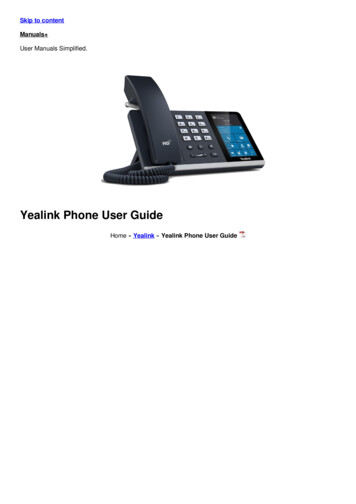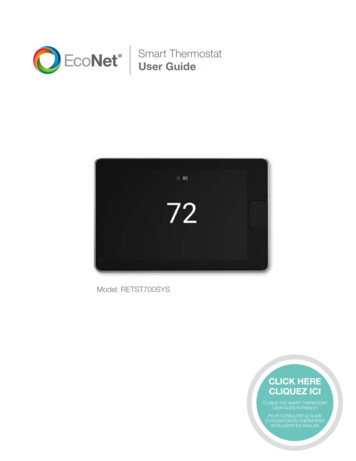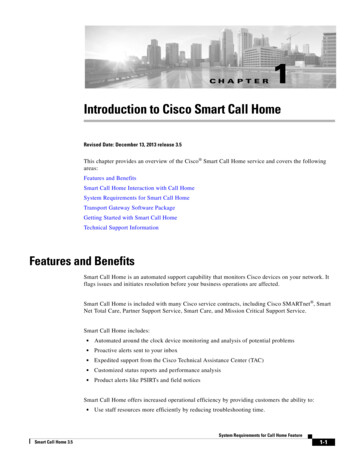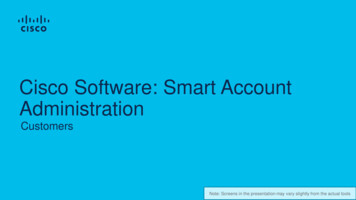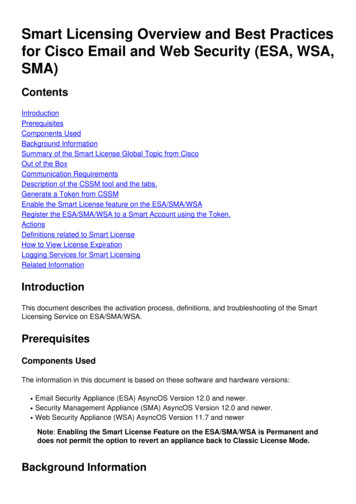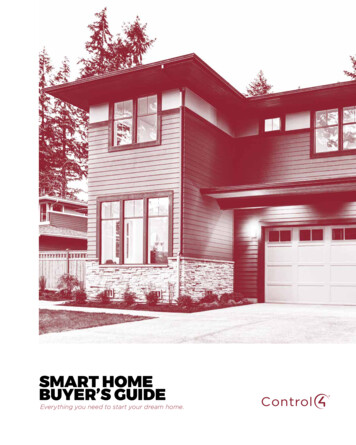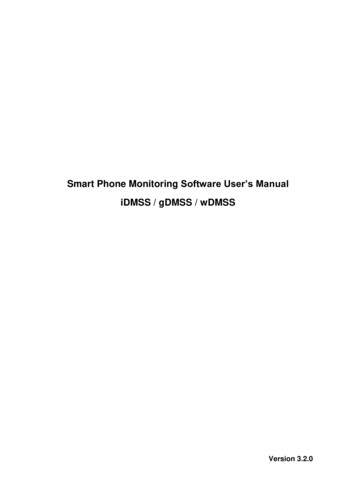
Transcription
Smart Phone Monitoring Software User’s ManualiDMSS / gDMSS / wDMSSVersion 3.2.0
Table of Contents1OVERVIEW. 11.1General Introduction . 11.2Features . 11.3Compatible Models . 12DOWNLOADING AND INSTALLATION . 23OPERATION. 23.1Main Menu . 23.2Device Manager . 33.2.1Add Device. 33.2.2Modify Device Info . 53.2.3Delete Device . 53.2.4Remote Configuration . 63.2.5View HDD Information . 83.2.6Alarm Out Control . 93.2.7Import Cloud Device . 103.3Live Preview . 103.3.1Enable Monitoring . 113.3.2Close Monitoring . 133.3.3Record . 143.3.4Snapshot . 143.3.5Favorites . 143.3.6Real-time Playback . 163.3.7PTZ . 163.3.8Bit Stream Switch . 183.3.9Alarm Out Control . 193.3.10Light Control . 203.3.11Lightness Setting . 213.3.12Full Screen . 223.4Playback . 233.4.1Record Playback . 233.4.2Picture Playback . 24To playback picture: . 243.53.5.1File Manager . 25View File . 25i
3.5.2Share File. 253.5.3Export File . 263.6E-Map. 263.6.1Create E-Map . 263.6.2Edit E-Map . 273.7Favorites . 273.8Alarm Push . 283.8.1Push Config . 283.8.2Instant View of Alarm Push. 293.8.3Alarm Push Event List . 293.9Local Config . 30ii
1 Overview1.1 General IntroductionThis manual is designed for smart phone to perform monitoring function. It is built on traits of mobiledevice to include functions of multiple touch control, touch signal recognition, alarm push, P2Pfunction, DDNS analysis and etc. User can preview, control PTZ, play video and etc. from front-endcamera, DVR, and speed dome, under 3G, 4G and WIFI environments.This software supports iOS and Android platforms only while iDMSS suppers iOS, and gDMSSsupports Android.1.2 FeaturesThis software has the following features: Support multiple channel monitoring and playback with a max of 16 windows. Support real-time playback when preview. Playback supports quick, slow and by frame modes. Support local snapshot and recording. Corresponding files are stored locally. Support PTZ control by slide on touch screen. Support memory of previous channel viewed last time. Support color setting and streaming parameters adjustment. Support alarm push. Support alarm output control from smart phone for alarm push function. Support bidirectional talk. Support “Smart Picture” function which zooms in/out picture to view different parts of picture ondifferent windows and at the same time. Support E-Map function, to show cameras on an electronic map of household or area. Support channel resolution and frame Config, and view of HDD info.1.3 Compatible ModelsAndroidiphoneAndroid 2.2 and higher, Resolution: 480*800 and higherNote:To use the push function, you need to create a Google account first.IOS 4.3 and higher1
2 Downloading and InstallationApp available for Android, iOS, Blackberry, Symbian, Windows Mobile and Windows 7 mobileFrom your compatible Smartphone, access the App Marketplace and download the free App. Thismay also be listed as:iDMSS lite for Apple iOSgDMSS lite for AndroidDMSS lite for othersiDMSS plus for Apple iOSgDMSS plus for Android2
3 Operation3.1 Main MenuOpen app, you will see Live Preview interface in Figure 3- 1 by default.Figure 3- 1Click on, system displays main menu interface in Figure 3- 2.2
Figure 3- 2User can click on function in main menu to enter corresponding function interface.Main functions includes: Live Preview, Playback, Device Manager, Local Files, E-Map, Favorites,Push Config, Event List, Local Config and Help.3.2 Device ManagerIn Device Manager, you can add device, modify device info, remotely configure device, controlalarm output, view HDD and delete. You also can import device list on cloud-end. Click on addeddevice in the list, you can see its functional buttons.3.2.1 Add DeviceTo add device:Step 1. In device manager interface, click onto enter add device interface, see Figure 3- 3.3
Figure 3- 3ParameterRegister ModeNameSNAddressIP/Domain and PortUsername/PasswordLivePreview/PlaybackNote P2P: for network environment, device should have P2P featureenabled and connects to internet. Add device by scanning QRcode or inputting SN. Dahua/QuickDDNS: for network environment, device has registerin DDNS server and connects to internet. Add device by inputtingcomplete DDNS domain name address, and analysis is done byDahuaDDNS and QuickDDNS. IP/Domain name: for normal environment, add device byinputting its IP address or third-party domain name and port.Device name. P2P type: input SN. QuickDDNS/Dahua type: input complete domain name. IP/Domain name type: input IP address or complete third partydomain name and port.Device username and password are both admin by default. If changed,please input new username and password.Select main stream or extra stream for live preview and playback.Step 2. Fill in parameter, and click onto save.Tip: You can click on Start Live Preview to view all channels of the device. System will go tomonitoring page and save device info. For device supporting P2P, you can scan QR code, input SN to add device.4
3.2.2 Modify Device InfoTo modify device information:Step 1. In device manager interface, click on device. System shows dropdown menu in Figure 3- 4.Figure 3- 4Step 2. Click onin dropdown menu.Step 3. Change device info, and click onto save.3.2.3 Delete DeviceTo delete device:Step 1. In device manager interface, click on device. System shows dropdown menu in Figure 3- 5.5
Figure 3- 5Step 2. Click onin dropdown menu. System asks if to delete the device.Step 3. Click on OK.3.2.4 Remote ConfigurationVia remote configuration, you can perform function of motion detect, alarm setting, camera setting,storage manager and user manager.To configure:Step 1. In device manager interface, click on device. System shows dropdown menu in Figure 3- 6.6
Figure 3- 6Step 2. Click onin dropdown list.Step 3. Select correspodning item to remote configuration page as in Figure 3- 7.Figure 3- 77
3.2.5 View HDD InformationYou can view HDD name, status, free capacity and total capacity.Step 1. In device manager interface, click on device. System shows dropdown menu in Figure 3- 8.Figure 3- 8Step 2. In dropdown menu, click onto view HDD information. See Figure 3- 9.8
Figure 3- 93.2.6 Alarm Out ControlYou can enable and disable alarm output of channel.To enable or disable alarm output:Step 1. In device manager interface, click on device. System shows dropdown menu in Figure 3- 10.Figure 3- 109
Step 2. In dropdown menu, click onStep 3. Select alarm out channel, click on.to enable or disable alarm out in Figure 3- 11.Figure 3- 113.2.7 Import Cloud DeviceYou can import cloud device. For example, you have a cloud account (i.e. DDNS account orEasy4IP account), and the account is bound with device, then you can import correspondingdevices on client without manually adding one by one.To import cloud device:Step 1. In device manager interface, click on import cloud device button.Step 2. Select cloud account type, and input username and password. DahuaDDNS:use cloud account on Dahua DDNS. QuickDDNS: use cloud account on Quick DDNS. PSP: use cloud account on Easy4IP server.Step 3. Click on Login to import device under the cloud account.Note:Device from DDNS account will have “?” mark. DDNS only memorizes IP the binding relationshipbetween the device and domain name. The”?” means there is incomplete information of device userand password which shall be completed later.3.3 Live Preview10
Click onand click on Live Preview in main interface to enter live preview in Figure 3- 12. If it isyour first time opening this app, you will see live preview interface.Figure 3- 12Slice tool bar at the bottom to display more buttons as in:IconNoteIconNote1/4/9/16 splitOpen/Close bit stream controlpanelOpen channels;Close all channelsOpen/Close alarm out controlpanelFavoritesOpen/Close audioLocal snapshotOpen/Close bidirectional talkStart/Stop video in currentwindowOpen/Close light control panelStart/Stop playbackOpen/Close image adjustmentcontrol panelOpen/Close PTZ control panel3.3.1 Enable MonitoringThe app supports 4 methods to open monitoring.1. In corresponding window open monitoring video of a certain window.Click onin window, select channel of device displayed as to monitor the selected channel.11
2.Open monitoring video of multiple windows.Click onat the upper-right corner, and select one or more channels in displayed devicelist. Click on Start Live Preview at the lower bottom. System will display monitoring video fromfirst window in sequence as in Figure 3- 13.Figure 3- 133.Quick previewAfter you add device, click on Start Live Preview to enable preview in Figure 3- 14.12
Figure 3- 144.Open last channelsClick onto open channels viewed last time3.3.2 Close MonitoringSystem supports two methods to close monitoring.1. Close a single channel.Long press monitoring window you want to close and drag it to the trashcan, it will be deleted.See Figure 3- 15.13
Figure 3- 152.Close all monitoring channelsClick on3.3.3to close all monitoring channels.RecordSelect designated record channel and click onto start record. Record status on bar at thebottom will show a red dot. Click this button again to stop recording of the channel.3.3.4SnapshotSelect channel to snapshot, click onto snapshot current channel.You can view snapshots under local file path. Android device can view snapshots directly under appinstallation path.3.3.5 FavoritesSystem supports favorites.In live preview interface, click onto show favorites panel, see Figure 3- 16.14
Figure 3- 16 Click onto quickly open all channls included in favorites group. Click onto add channels in preview to favorites group. Click on channel to add and clickon. See Figure 3- 17.15
Figure 3- 173.3.6Real-time PlaybackIn live preview, click on, the selected channel will play video of the previous 15 seconds.Note:System default playback is 15 seconds. You can set playback time in local config.Click onto end payback and return to monitoring mode.3.3.7 PTZ3.3.7.1 Direction and ZoomingClick onto activate PTZ panel. The selected window will be maximized as in Figure 3- 18.16
Figure 3- 18When PTZ control is activated, use hand to control PTZ direction by sliding touch screen: PTZ rotation: slide the touch screen toward designated direction to rotate PTZ. Focus control: Slide with two fingers to control focus.You also can:IconNoteZoom controlFocus controlIris control3.3.7.2 PresetOn PTZ panel, click on, select preset no., and click onto adjust this preset point as in Figure3- 19.Figure 3- 1917
3.3.7.3 EPTZOn PTZ panel, click on, switch to EPTZ mode. Under this mode, you also can slide touchscreen to control video display zoom in/out.Note:PTZ function is for camera with PTZ fucntion only. EPTZ is supported by all devices.3.3.8 Bit Stream SwitchSystem switches live preview and bit stream switch.Step 1. Under live preview, select a preview window, click on. System displays bit streamswitch panel as in Figure 3- 20.Figure 3- 20IconNoteHD modeFluent modeCustom modeStep 2. You can switch between main and extra stream. Click on, to switch to HD mode (main stream). Click on, to switch to fluent mode (extra stream). Click on, may customize main/extra stream as in Figure 3- 21.18
Figure 3- 213.3.9 Alarm Out ControlSystem supports to enable or disable device alarm output.Step 1. Under live preview, select a monitoring channel, click onbutton. Open correspondingalarm output of channel, see Figure 3- 22.Figure 3- 22Step 2. Click on enable button to enable or disable a certain alarm output.19
3.3.10 Light ControlSystem supports to enable or disable device compensation light.Step 1. Under live preview, select a monitoring channel, click onbutton, open correspondinglight panel of the channel as in Figure 3- 23.Figure 3- 23Step 2. Click on on/off button to turn on/off compensation light.Step 3. Click onorto adjust light.Note:Only K100 supports light control.20
3.3.11 Lightness SettingSystem supports image adjustment including brightness, contrast, saturation and etc.Step 1. In live preview, select a monitoring window, click onbutton, open image adjustmentcontrol panel in Figure 3- 24.Figure 3- 24IconNoteAdjust brightnessAdjust contrastAdjust colorAdjust saturationWeightStep 2. Click on functional icon to adjust corresponding effect. You can increase/decreaseparameter by clicking on /- buttons in monitoring window.21
3.3.12 Full ScreenIn live preview, screen is rotated and enters full screen mode as in Figure 3- 25.Figure 3- 25Note:If you cannot enter full screen mode, please check the settings of mobile phone.22
3.4 PlaybackSystem supports record playback and picture playback.Record playback is to play record saved on device; picture playback is to play picture saved onfront-end device.Click onbutton to view main menu. Click on playback on main menu to enter playback interface.The default is to play record, but you can switch it to picture by clicking on tab above.3.4.1Record PlaybackFigure 3- 26To search record:Step 1. Click onin window to open device list.Step 2. Select playback period.Step 3. Select record channel to view. System can play video of selected channel in selectedwindow as in Figure 3- 27.23
Figure 3- 27ParameterNotePlay tool bar control, including 5 min, 30 min, 60 min.Previous/NextQuick/Slow Quick: quick play with 2x or 4x speed. Select playing video, clickon to 2x play; click on, to 4x play. During 4x play, clickonto 2x play and click on it again back to normal speed.Slow: slow play with 1/2x, 1/4x speed. Select playing video, clickonto 1/2 play; click onto 1/4 play. During 1/4 play, clickonto 1/2 play and click on it again back to normal speed.Play/PausePlay by frame. Click onto play next frame.You can close playback by either of: Close a single channel playback: long press video to close playback and drag it to the trashcanabove. Close all channels’ playback: click onto close all playback.3.4.2 Picture PlaybackTo playback picture:Step 1. Click onbutton to open deivce list.Step 2. Select playback period.Step 3. Select picture channel to view. System will play picture of selected channel in selectedwindow.24
Click on Smart mode: during picture playback, click onto close playback.to enter smart mode. Window becomes 4-split. You can zoom in/out in window 2/3/4 as in Figure 3- 28.Figure 3- 283.5 File ManagerSystem supports viewing, editing, exporting of live preview and snapshot, record during playback.3.5.1 View FileClick on record file to view. In the interface, you can play, pause, snapshot, play audio, quickly play,slowly play and etc.3.5.2Share FileStep 1. Click onor long press file to enter file manager mode.Step 2. Select file to share.Step 3. Click onto share file.Note:For Android only.25
3.5.3Export FileStep 1. Click onor long press local file to enter manager mode.Step 2. Select file to export.Step 3. Click onto export video as in Figure 3- 29.Figure 3- 29Note:Android OS do not need to export picture and user can find picture under installation path.3.6 E-Map3.6.1Create E-MapStep 1. Click onto add one picture as map.Step 2. Click onto add monitoring spot on map. Go to device list interface and select channel.Step 3. Place added channel on appropriate location on map and click onto save. See Figure3- 30.26
Figure 3- 303.6.2Edit E-MapSelect added e-map, click onbutton to editing mode. Click onto siwtch map. Click onto add monitoring spot. Click onto delete monitoring spot.3.7 FavoritesSystem supports to create new favorites, or add monitoring spot to existing favorites.Step 1. Click onand input name.Step 2. Enter a certain favorite group, click ondesignated channel and click onat upper-right corner to enter device list. Checkto add it into favorites.You can delete favorites: Delete favorite (Android): long press favorite to delete and click on delete in pop-up box. Delete favorite (iOS): At row of favorite to delete, slide the delete button and click on deletebutton.27
You can remove monitoring spot in favorites: Delete video channel in favorites (Android): enter favorites, long press channel to delete. Clickon OK to delete it. Delete video channel in favorites (iOS): At row of channel to delete, slide the delete button andclick on delete button.3.8 Alarm PushAlarm push function is the function to push alarm info generated on device to mobile phone byintegrating device alarm module. User can view alarm record, preview and playback pictureaccording to push info.3.8.1 Push ConfigStep 1. Select device to push.Step 2. Edit valid period and select push type.ParameterNoteValid period During valid period, you can receive alarm push.Range: 1 365.Push TypeIn includes video and picture. If current device has record, and thispush type is video, so when you receive push info, you can play therecord. This is similar for the case of picture.Step 3. Select alarm info, and select channel to push. Click onto save. See Figure 3- 31.Figure 3- 3128
3.8.2 Instant View of Alarm PushAfter you have set push info, when front-end device generates alarm push, client-end will receivealarm info from the device. You can click on info in notice bar to view detailed info. System will openrecord/picture according to the priority set by you. If there is no record or picture, system will go tolive preview.In info viewing interface, click on tab above to switch to alarm record, alarm picture and live previewas in Figure 3- 32.Figure 3- 32Note: Android user need to login Google account. Video and picture push requires storage medium on front-end device and you must set alarmrecord. System supports to store up to 50 historical records in event list.3.8.3 Alarm Push Event ListYou can view historical record in event list.29
3.9 Local ConfigSystem supports local configuration including PTZ step, capture mode, push duaration, video modeand etc. See Figure 3- 33.Figure 3- 33ParameterPTZ StepCapture ModePush DurationVideo ModeReal-timePlaybackProtectionNoteUsed to set PTZ step during live preview.The larger the step length, the higher the speed will be.Range: 1 8。Configure continuous snapshot quantity in live preview interfaceand etc. There are three modes: 1, 3 and 5.Set corresponding playback duration of push info, including:15s, 30s, 1min, 2min, 5min.Default is higher-performance mode.If you encounter window split error or system crash, pleasewitch to compatible mode.Set playback period, as 5s 60s adjustable.Set password protection of mobile monitoring app.After you have set password, every time you login, you mustverify password for security purpose.30
Note: This user’s manual is for reference only. Slight difference may be found in user interface. All the designs and software here are subject to change without prior written notice. All trademarks and registered trademarks mentioned are the properties of theirrespective owners. If there is any uncertainty or controversy, please refer to the final explanation of us. Please visit our website or contact your local service engineer for more information.31
App available for Android, iOS, Blackberry, Symbian, Windows Mobile and Windows 7 mobile From your compatible Smartphone, access the App Marketplace and download the free App. This may also be listed as: iDMSS lite for Apple iOS gDMSS lite for Android DMSS lite for others iDMSS plus for Apple iOS gDMSS plus for Android

